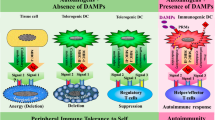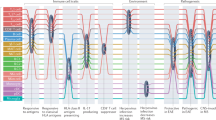Abstract
Single-nucleotide polymorphisms close to IL22RA2, coding for the soluble interleukin (IL)-22-binding protein (IL-22BP), are strongly and reproducibly associated with multiple sclerosis (MS), but there is little data on how this molecule may affect neuroinflammation. Here, we have studied the mouse ortholog in C57BL/6 wild-type and Il22ra2-deficient mice in the context of experimental autoimmune encephalomyelitis (myelin oligodendrocyte glycoprotein-EAE). In wild-type mice, we demonstrated changes in the levels of transcripts for IL-22, the signaling IL-22 receptor and IL-22BP in lymphoid tissues at the time of T-cell priming and in the inflamed central nervous system (CNS). Because IL-22BP is known to antagonize IL-22 signaling, a primarily pro-inflammatory cytokine, we hypothesized that the Il22ra2-deficient mice would have more severe EAE. Paradoxically, the knockout mice displayed a less severe disease course, less demyelination and less infiltration of immune cells in the CNS. The most straightforward interpretation of our findings is that lack of IL-22BP leads to a higher availability of IL-22, which in the case of CNS inflammation, surprisingly acts in a protective fashion. Thus, deletion of the ortholog of the MS risk gene Il22ra2 in mice has beneficial effects on EAE, which may be considered in new therapeutic strategies for treating neuroinflammation.
This is a preview of subscription content, access via your institution
Access options
Subscribe to this journal
Receive 6 digital issues and online access to articles
$119.00 per year
only $19.83 per issue
Buy this article
- Purchase on Springer Link
- Instant access to full article PDF
Prices may be subject to local taxes which are calculated during checkout







Similar content being viewed by others
References
Sobocki P, Pugliatti M, Lauer K, Kobelt G . Estimation of the cost of MS in Europe: extrapolations from a multinational cost study. Mult Scler 2007; 13: 1054–1064.
Sawcer S, Hellenthal G, Pirinen M, Spencer CCA, Patsopoulos NA, Moutsianas L et al. Genetic risk and a primary role for cell-mediated immune mechanisms in multiple sclerosis. Nature 2011; 476: 214–219.
Beecham AH, Patsopoulos NA, Xifara DK, Davis MF, Kemppinen A, Cotsapas C et al. Analysis of immune-related loci identifies 48 new susceptibility variants for multiple sclerosis. Nat Genet 2013; 45: 1353–1360.
Gregory AP, Dendrou CA, Attfield KE, Haghikia A, Xifara DK, Butter F et al. TNF receptor 1 genetic risk mirrors outcome of anti-TNF therapy in multiple sclerosis. Nature 2012; 488: 508–511.
Couturier N, Bucciarelli F, Nurtdinov RN, Debouverie M, Lebrun-Frenay C, Defer G et al. Tyrosine kinase 2 variant influences T lymphocyte polarization and multiple sclerosis susceptibility. Brain 2011; 134: 693–703.
Lundström W, Highfill S, Walsh STR, Beq S, Morse E, Kockum I et al. Soluble IL7Rα potentiates IL-7 bioactivity and promotes autoimmunity. Proc Natl Acad Sci USA 2013; 110: E1761–E1770.
Beyeen AD, Adzemovic MZ, Ockinger J, Stridh P, Becanovic K, Laaksonen H et al. IL-22RA2 associates with multiple sclerosis and macrophage effector mechanisms in experimental neuroinflammation. J Immunol 2010; 185: 6883–6890.
Silverberg MS, Cho JH, Rioux JD, McGovern DPB, Wu J, Annese V et al. Ulcerative colitis-risk loci on chromosomes 1p36 and 12q15 found by genome-wide association study. Nat Genet 2009; 41: 216–220.
Strange A, Capon F, Spencer CCA, Knight J, Weale ME, Allen MH et al. A genome-wide association study identifies new psoriasis susceptibility loci and an interaction between HLA-C and ERAP1. Nat Genet 2010; 42: 985–990.
Trynka G, Hunt KA, Bockett NA, Romanos J, Mistry V, Szperl A et al. Dense genotyping identifies and localizes multiple common and rare variant association signals in celiac disease. Nat Genet 2011; 43: 1193–1201.
Xu W, Presnell SR, Parrish-Novak J, Kindsvogel W, Jaspers S, Chen Z et al. A soluble class II cytokine receptor, IL-22RA2, is a naturally occurring IL-22 antagonist. Proc Natl Acad Sci USA 2001; 98: 9511–9516.
Dumoutier L, Lejeune D, Colau D, Renauld JC . Cloning and characterization of IL-22 binding protein, a natural antagonist of IL-10-related T cell-derived inducible factor/IL-22. J Immunol 2001; 166: 7090–7095.
Jones BC, Logsdon NJ, Walter MR . Structure of IL-22 bound to its high-affinity IL-22R1 chain. Structure 2008; 16: 1333–1344.
Huber S, Gagliani N, Zenewicz LA, Huber FJ, Bosurgi L, Hu B et al. IL-22BP is regulated by the inflammasome and modulates tumorigenesis in the intestine. Nature 2012; 491: 259–263.
Martin JCJ, Bériou G, Heslan M, Chauvin C, Utriainen L, Aumeunier A et al. Interleukin-22 binding protein (IL-22BP) is constitutively expressed by a subset of conventional dendritic cells and is strongly induced by retinoic acid. Mucosal Immunol 2014; 7: 101–113.
Wolk K, Kunz S, Witte E, Friedrich M, Asadullah K, Sabat R . IL-22 increases the innate immunity of tissues. Immunity 2004; 21: 241–254.
Sonnenberg GF, Fouser LA, Artis D . Border patrol: regulation of immunity, inflammation and tissue homeostasis at barrier surfaces by IL-22. Nat Immunol 2011; 12: 383–390.
Liang SC, Tan X-Y, Luxenberg DP, Karim R, Dunussi-Joannopoulos K, Collins M et al. Interleukin (IL)-22 and IL-17 are coexpressed by Th17 cells and cooperatively enhance expression of antimicrobial peptides. J Exp Med 2006; 203: 2271–2279.
Langrish CL, Chen Y, Blumenschein WM, Mattson J, Basham B, Sedgwick JD et al. IL-23 drives a pathogenic T cell population that induces autoimmune inflammation. J Exp Med 2005; 201: 233–240.
Kreymborg K, Etzensperger R, Dumoutier L, Haak S, Rebollo A, Buch T et al. IL-22 is expressed by Th17 cells in an IL-23-dependent fashion, but not required for the development of autoimmune encephalomyelitis. J Immunol 2007; 179: 8098–8104.
Mildner A, Mack M, Schmidt H, Brück W, Djukic M, Zabel MD et al. CCR2+Ly-6Chi monocytes are crucial for the effector phase of autoimmunity in the central nervous system. Brain 2009; 132: 2487–2500.
King IL, Dickendesher TL, Segal BM . Circulating Ly-6C+ myeloid precursors migrate to the CNS and play a pathogenic role during autoimmune demyelinating disease. Blood 2009; 113: 3190–3197.
vanOosten B, Barkhof F, Truyen L, Boringa J, Bertelsmann F, vonBlomberg B et al. Increased MRI activity and immune activation in two multiple sclerosis patients treated with the monoclonal anti-tumor necrosis factor antibody cA2. Neurology 1996; 47: 1531–1534.
Arnason B, Jacobs G, Hanlon M, Clay B, Noronha A, Auty A et al. TNF neutralization in MS: results of a randomized, placebo-controlled multicenter study. Neurology 1999; 53: 457–465.
Wolk K, Witte E, Hoffmann U, Doecke W, Endesfelder S, Asadullah K et al. IL-22 induces lipopolysaccharide-binding protein in hepatocytes: a potential systemic role of IL-22 in Crohn’s disease. J Immunol 2007; 178: 5973–5981.
Kebir H, Kreymborg K, Ifergan I, Dodelet-Devillers A, Cayrol R, Bernard M et al. Human TH17 lymphocytes promote blood-brain barrier disruption and central nervous system inflammation. Nat Med 2007; 13: 1173–1175.
Ke Y, Sun D, Jiang G, Kaplan HJ, Shao H . IL-22-induced regulatory CD11b+ APCs suppress experimental autoimmune uveitis. J Immunol 2011; 187: 2130–2139.
Storch MK, Stefferl A, Brehm U, Weissert R, Wallström E, Kerschensteiner M et al. Autoimmunity to myelin oligodendrocyte glycoprotein in rats mimics the spectrum of multiple sclerosis pathology. Brain Pathol 1998; 8: 681–694.
Adzemovic MZ, Zeitelhofer M, Eriksson U, Olsson T, Nilsson I . Imatinib ameliorates neuroinflammation in a rat model of multiple sclerosis by enhancing blood-brain barrier integrity and by modulating the peripheral immune response. PLoS ONE 2013; 8: e56586.
Acknowledgements
This study received grant support from the Swedish Research Council, Knut and Alice Wallenberg Foundation, the Swedish Brain Foundation, the AFA Foundation, the Swedish Foundation for Persons with Neurological Disabilities and the EURATRANS (FP7/2007-2013, Health-F4-2010-241504).
Author information
Authors and Affiliations
Corresponding author
Ethics declarations
Competing interests
Dr Olsson has received personal compensation from Biogen Idec, Merck, Novartis, TEVA, Sanofi-aventis, Genzyme, Almirall, Actelion as member of scientific advisory boards, steering committees or independent data monitoring boards in clinical trials, or as speaker at meetings. His research unit has received unrestricted multiple sclerosis research support from Biogen Idec, Bayer Schering, Merck, Sanofi-aventis, Novartis, the Swedish Research Council, Knut and Alice Wallenbergs Foundation, the AFA Foundation and the Swedish Brain Foundation. The remaining authors declare no conflict of interest.
Rights and permissions
About this article
Cite this article
Laaksonen, H., Guerreiro-Cacais, A., Adzemovic, M. et al. The multiple sclerosis risk gene IL22RA2 contributes to a more severe murine autoimmune neuroinflammation. Genes Immun 15, 457–465 (2014). https://doi.org/10.1038/gene.2014.36
Received:
Revised:
Accepted:
Published:
Issue Date:
DOI: https://doi.org/10.1038/gene.2014.36
This article is cited by
-
Supplementation with the Probiotic Strains Bifidobacterium longum and Lactiplantibacillus rhamnosus Alleviates Glucose Intolerance by Restoring the IL-22 Response and Pancreatic Beta Cell Dysfunction in Type 2 Diabetic Mice
Probiotics and Antimicrobial Proteins (2023)
-
IL-22-binding protein exacerbates influenza, bacterial super-infection
Mucosal Immunology (2019)
-
Biological and pathological activities of interleukin-22
Journal of Molecular Medicine (2016)
-
Interleukin-22 is increased in multiple sclerosis patients and targets astrocytes
Journal of Neuroinflammation (2015)



